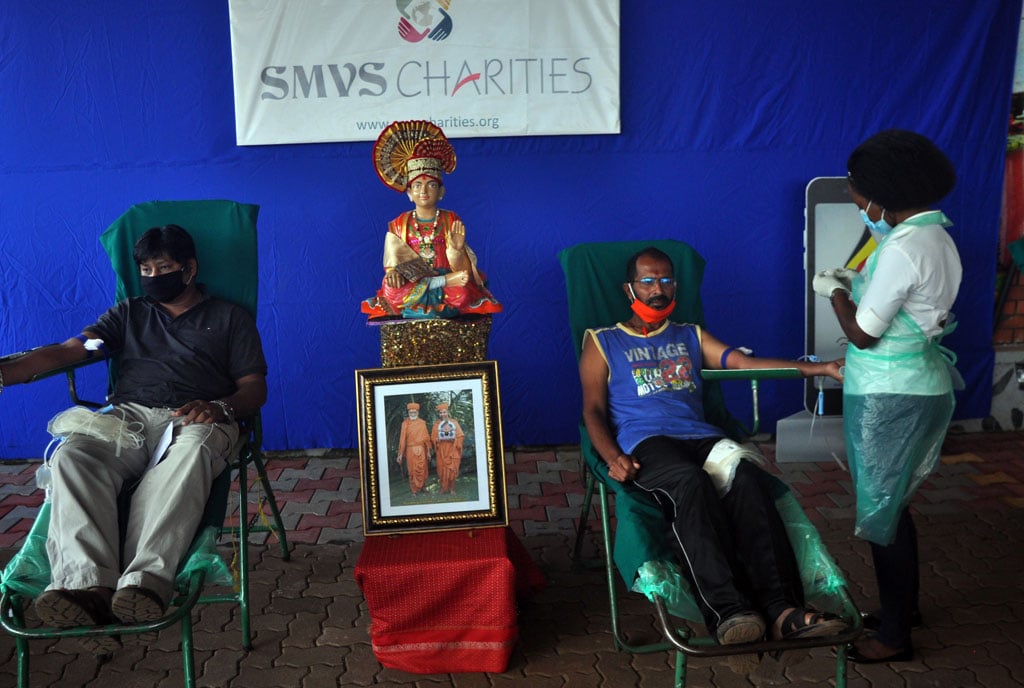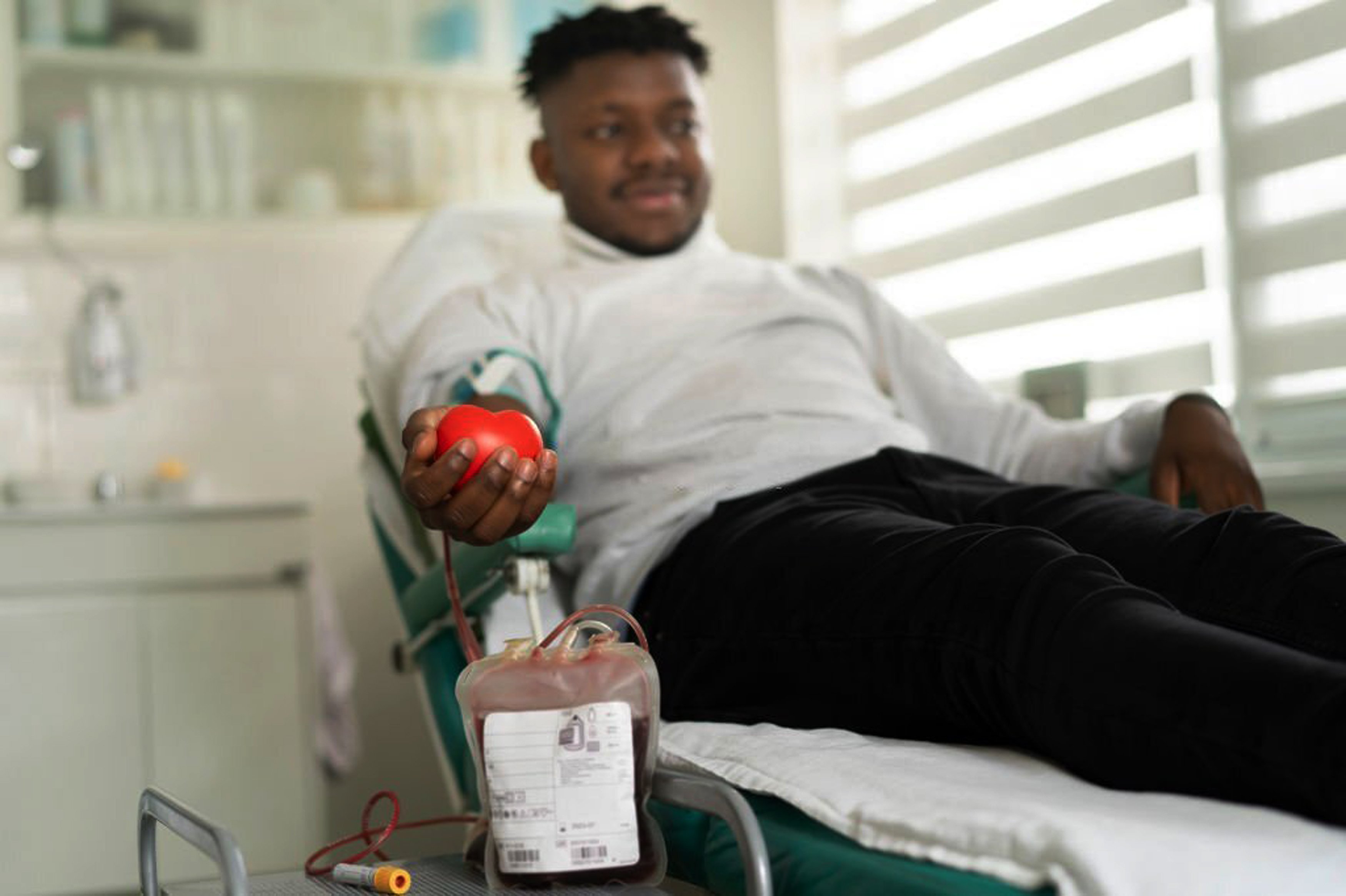Prime
Collectors defy odds as demand for blood grows

Members of the Swaminarayan Mandir Vasna Sanstha Temple Kamwokya donate blood at the Kamwokya Temple where they collected 130 units of blood in 2022. PHOTO/STEPHEN OTAGE.
What you need to know:
- Despite the shortfalls in staffing levels and demand for more equipment, the Uganda Blood Transfusion Services managed to surpass its targeted blood units for FY2021/2022.
When a bus rammed into a stationary trailer in Kamdini Town Council on the Kampala-Gulu Highway two Thursday nights ago, one of the accident’s victims was a four-year-old boy.
When the boy was wheeled into St John XXIII Hospital-Aber in Oyam District, surgeons were left with no choice but to amputate his arm. The boy was, however, not out of the woods.
“…all of us thought the child would not survive because we didn’t have blood in our blood bank,” Mr
Eugene Odur, a human resource officer at the hospital, would later reveal.
Fortunately for the boy, one hospital staff member volunteered to donate blood. Not everyone is as lucky as eight regional blood banks in the country continue to run low on supply.
Their predicament can be traced back to the woes of Uganda Blood Transfusion Services (UBTS).
Budget estimates indicate that its resource envelope has been slashed from Shs23.657b this financial year to Shs21.899b for FY2023/2024.
UBTS’ budget framework paper for FY2023/2024 prioritises filling up staffing gaps, procuring new blood donation vehicles, and boosting activities in the eight regional blood banks.
Uganda has regional blood banks in Arua, Mbale, Gulu, Lira, Nakasero, Masaka, Mbarara, and Fort Portal. These are supported by nine blood collection centres in Hoima, Masaka, Kabale, Rukungiri, Jinja, Soroti, Mengo and Moroto.
Requirements
UBTS has also underscored in its budget framework paper the need to buy at least six centrifuges to be sent to all but two of the regional blood banks. Whole blood is often separated using a centrifuge into components for storage and transport.
Ms Dorothy Kyeyune, UBTS’ executive director, told the House Committee on Health this week that Shs108b will be required to buttress the blood collection exercise alone.
UBTS says it costs at least $80 (about Shs293,000) to process and deliver each unit of blood countrywide.
“The target for FY2023/2024 is 360,000 units of blood. This will require $28.8m (about Shs107b) to collect, process and issue,” Ms Kyeyune revealed, adding, “Currently, UBTS has been allocated Shs62b, leaving a shortfall of about Shs50b.”
Ms Kyeyune further revealed that the marked improvement in health care delivery in the country has fuelled a burning desire for blood.
“The demand for safe blood transfusion increases for heart surgery, cancer treatment, accidents and other related illnesses,” she said.
To effectively collect the said targeted units of blood, the UBTS needs to deploy brand new vehicles capable of manoeuvring the tough terrain in the countryside.
The vehicle—each valued at Shs350m—will in their totality gobble Shs1.78b.
“If we are to have 38 blood collection teams, each blood collection team must have two vehicles—one for blood collection and another for mobilisation,” Ms Kyeyune told the parliamentary committee, adding, “…we need 76 [vehicles … as] 55 out of the total fleet of 63 vehicles have exceeded the recommended five-year useful life, and their mileage above the recommended 250,000km.”
Staff gaps
UBTS currently operates with 296 staff instead of the approved 424. Ms Mary Nakigudde, the senior human resource officer, told lawmakers that this has been the case for the past four years “despite our continuous efforts to lobby for funds to cover the vacant positions.”
“Based on our strategic plan, we need 13 additional teams with a composition of 10 critical staff, which is 130, to be able to massively collect blood,” she said, adding that the “296 staff are overwhelmed and stretched.”
As a stopgap measure, UBTS currently banks on volunteers to mobilise blood donors and collect blood. This has handicapped the entity’s operations, with blood collection from communities proving quite difficult.
“The yield from communities is not as good as the yield from schools. You go to a community where you expect 50 units per day as a target, you get 20 units. So we need to spend more,” Ms Kyeyune revealed this week.
Despite the shortfalls in staffing levels and demand for more equipment, the UBTS managed to surpass its targeted blood units for FY2021/2022.
“We surpassed the target by collecting 313,975 units of blood versus a target of 300,000 units despite the Covid-19 pandemic,” Ms Kyeyune said.
What next?
As an immediate redress to reduce the demand of blood in the country, UBTS urged lawmakers to task other government entities to enforce preventive measures. The lawmakers were asked to push the Works ministry and Uganda Police Force to ensure discipline on Uganda’s roads. Accidents are notorious for transferring an immense burden on the blood unit since most patients tend to require blood refills.
The entity plans to collect at least 360,000 units of blood in the FY2023/2024. UBTS also plans to construct and equip more regional blood collection blood banks, establish blood repository centres at district general hospitals. It also intends to set up a research centre to facilitate deeper studies into the blood sector in the country.
The government has been urged to avail funds to run the Mengo Hospital Blood Bank. The facility was recently constructed courtesy of resources mobilised under the Mengo Hospital’s rotary society.




